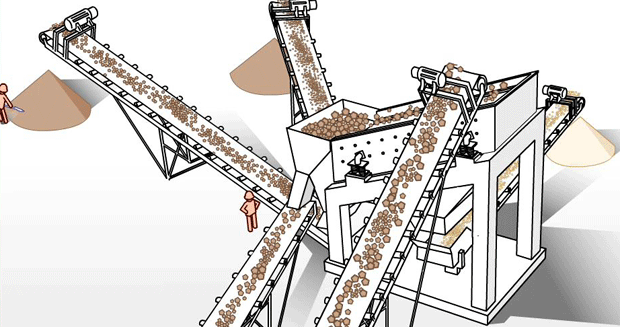
The stationary construction waste treatment production line is composed of crushers, screening machines, silos, feeders, conveyors, ventilation and dust removal equipment and control systems. Due to the different raw material conditions and product requirements, there can be different combinations to meet the needs of different process requirements and different production scales.
Construction waste characteristics
Construction waste has the characteristics of complex composition, large differences in hardness, and uneven size, which makes it difficult to handle:
Complex composition
Construction waste includes a mixture of concrete (40% -60%), bricks (20% -30%), metals (5% -10%), and wood/plastic (5% -10%), with significant differences in hardness among different materials. For example, the Mohs hardness of concrete is 6-7, the compressive strength of bricks is about 10-15 MPa, the hardness of metal impurities (such as steel bars) is higher, and lightweight materials such as plastics are prone to equipment blockage.
Uneven size
Common large materials (such as concrete beams with dimensions exceeding 50cm × 30cm) coexist with small crushed materials. Traditional equipment has limited feeding port sizes (mostly ≤ 400mm × 300mm), requiring manual or mechanical pre cutting in advance, otherwise it can easily lead to material jamming and shutdown. Uneven material size can also cause stress imbalance in the crushing chamber, reducing efficiency.
Metal impurity interference
Metal impurities such as steel bars and iron wires in construction waste can cause high-speed friction with cutting tools, resulting in blade breakage or severe equipment vibration, and even structural damage. Traditional equipment lacks pre sorting function and cannot separate these interferences in advance.
Construction waste production line process
The first stage: Feeding and Sorting
The processing of construction waste crusher usually starts from feeding and sorting. Construction waste is first transported to the feed inlet of the garbage crusher equipment through a conveyor belt or loading device. During the feeding process, construction waste undergoes preliminary sorting to remove large debris and metallic substances, ensuring that subsequent crushing and processing can be more efficient and safe.
The second stage: Crushing and crushing
After preliminary sorting, the construction waste enters the crushing chamber of the construction waste crusher. Construction waste crushers usually use tools such as blades, hammers, or collision plates to crush and break up construction waste. During this process, construction waste is rapidly hit and broken, and large pieces of construction waste gradually refine into smaller particles
The third stage: Screening and Classification
The crushed construction waste enters the screening device. The screening device classifies construction waste particles according to their size through screens of different apertures, obtaining construction waste particles of different sizes. Common classifications include fine particles, medium particles, and coarse particles.
The fourth stage: Re screen and clean
The classified construction waste particles may still contain some impurities and pollutants. In order to improve the quality of construction waste reuse, it is necessary to re screen and clean the particles. This step usually uses equipment such as vibrating screens and wind screens to remove dust and other impurities from the surface of particles.
The fifth stage: Resource utilization
After the first few steps of processing, the construction waste particles have been cleaned and sorted. These construction waste particles can be used for various resource utilization methods. This includes the production of recycled aggregates, roadbed filling materials, and the manufacturing of environmentally friendly bricks. By scientifically utilizing construction waste particles, not only can we effectively reduce our dependence on natural resources, but we can also lower the environmental pollution caused by construction waste
The process flow of the construction waste crusher mainly includes feeding and sorting, crushing and crushing, screening and classification, re screening and cleaning, and resource utilization. Through this series of process steps, construction waste can be effectively processed and converted into reusable resources, achieving the goal of waste reduction and resource utilization

Contact: Hebe Wang
Phone: 008615092894665
Tel: 008615092894665
Email: info@sandmancrusher.com
Add: No.23 Yihe Road,Linyi City, Shandong Province, China
We chat
